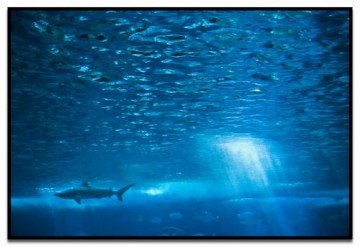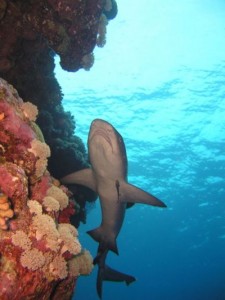With “Shark Week” upon us and the release of yet another Sharknado movie, it is easy to think of sharks as stereotypical ‘marauders of the sea’. Sharks, however, are endlessly fascinating creatures that provide many insights into the workings of ecology and evolution. Sharks constitute only about 450 of the more than 33,000 species of fishes, but they have been incredibly successful considering that they have been around for about 0.5 billion years and have been top predators from day one!

Shark in open ocean by Flickr user Vitorio Benedetti
A recent paper by Sorenson et al. highlights another amazing aspect of sharks and their biology. The how, where, and when of the origin of species is a central focus of many evolutionary biologists. How fast do species arise? Do particular periods in evolutionary time or certain places or habitat types generate more species than others? Sorenson et al. investigated this latter question using sharks as a model system. It has been hypothesized, for instance, that the rate of speciation in inshore marine areas is higher than in offshore areas and that coral reefs are particular hotspots of evolution (most marine fishes live in less than 100 feet of water). The basis for this idea is that inshore (and coral reef areas) have much greater complexity of habitat and more ways for populations to become separated from one another or specialize in particular habitat types – both factors that seem to elevate speciation (this may also be why freshwater fishes, that live in areas fragmented by the landscape, have 41 times the number of species per unit area of the Earth compared to marine fishes).
In their paper, Sorenson et al. test this idea by sequencing a series of genes from 268 species of sharks and ‘calibrated’ the molecular evolutionary tree with dates from fossil finds of some of the same shark species used in the molecular work. They used this information, along with geographic distributions, to see if particular habitat types were associated with greater speciation rates than other areas over a given time period.

Sorenson et al. found that the rate of species formation was no faster in inshore areas compared to the open sea, but that coral reef areas, indeed, seemed to foster the origin of new species in particular groups of sharks. Sorenson et al also found that “bursts” of speciation occurred following the end the Permian Period’s “mass-extinction” event (~ 300-250 million years ago) when 90% of all marine species were thought to have gone extinct. In the case of the latter, while mass extinctions clearly wipe-out vast numbers of species, they also provide incredible “ecological opportunity” for those groups of animals and plants that do survive and such opportunity is often associated with bursts of speciation.
So, Sorenson et al.’s study shows us that while we are often fascinated by the teeth of sharks and how they use them, the stories that their genes can tell are just as fascinating!
Photo credits: [thumnail] Lemon Shark by flickr user Willy Volk
[banner] Great White Shark by Flickr user Brook Ward
